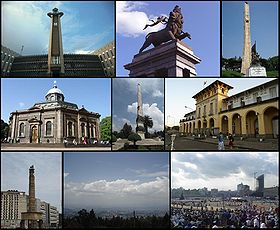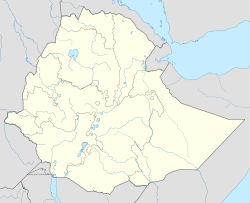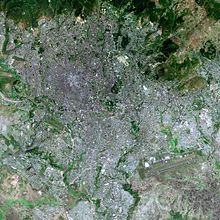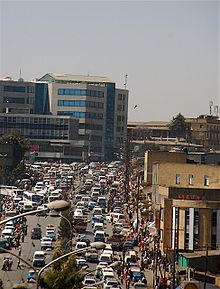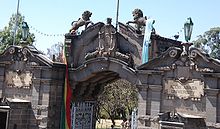- Addis Ababa
-
Addis Ababa
አዲስ አበባMontage of Addis Ababa Nickname(s): City of Humans[?], Adisaba, Sheger, Finfinne, Adu, Adu Genet Location in Ethiopia Coordinates: 9°1′48″N 38°44′24″E / 9.03°N 38.74°E Country  Ethiopia
EthiopiaChartered City Addis Ababa Chartered 1886 Government – Mayor Kuma Demeksa Area – City 530.14 km2 (204.7 sq mi) – Land 530.14 km2 (204.7 sq mi) Elevation 2,355 m (7,726 ft) Population (2008) – City 3,384,569 – Density 5,165.1/km2 (13,377.5/sq mi) – Urban 3,384,569 – Metro 4,567,857 [1] Time zone East Africa Time (UTC+3) Addis Ababa (sometimes spelled Addis Abeba, the spelling used by the official Ethiopian Mapping Authority) is the capital city of Ethiopia. (In Ethiopian languages: Amharic, Addis Abäba [adːiːs aβəβa] "new flower"; Oromo, Finfinne[citation needed]; Ge'ez ኣዲስ ኣበባ) It is the largest city in Ethiopia, with a population of 3,384,569 according to the 2007 population census.[1]
As a chartered city (ras gez astedader), Addis Ababa has the status of both a city and a state. It is where the African Union and its predecessor the OAU are based. Addis Ababa is therefore often referred to as "the political capital of Africa", due to its historical, diplomatic and political significance for the continent.[2] The city is populated by people from different regions of Ethiopia – the country has as many as 80 nationalities speaking 80 languages and belonging to a wide variety of religious communities. It is home to Addis Ababa University. The Federation of African Societies of Chemistry (FASC) and Horn of Africa Press Institute (HAPI) are also headquartered in Addis Ababa.
Contents
History
The site of Addis Ababa was chosen by Empress Taytu Betul and the city was founded in 1886 by her husband, Emperor Menelik II. The name of the city (ኣዲስ ኣበባ) was taken from parts of the city called hora Finfinnee ("hot springs") in Oromo[citation needed]. Another Oromo name of the city is Sheger. Menelik, as initially a King of the Shewa province, had found Mount Entoto a useful base for military operations in the south of his realm, and in 1879 visited the reputed ruins of a medieval town, and an unfinished rock church that showed proof of an Ethiopian presence in the area prior to the campaigns of Ahmad Gragn. His interest in the area grew when his wife Taytu began work on a church on Entoto, and Menelik endowed a second church in the area.
However the immediate area did not encourage the founding of a town due to the lack of firewood and water, so settlement actually began in the valley south of the mountain in 1886. Initially, Taytu built a house for herself near the "Filwoha" hot mineral springs, where she and members of the Showan Royal Court liked to take mineral baths. Other nobility and their staffs and households settled the vicinity, and Menelik expanded his wife's house to become the Imperial Palace which remains the seat of government in Addis Ababa today. The name changed to Addis Ababa and became Ethiopia's capital when Menelik II became Emperor of Ethiopia. The town grew by leaps and bounds. One of Emperor Menelik's contributions that is still visible today is the planting of numerous eucalyptus trees along the city streets.[3]
On 5 May 1936, Italian troops invaded Addis Ababa during the Second Italo-Abyssinian War, making it the capital of Italian East Africa from 1936 to 1941 after killing about a million Ethiopians with mustard gas[citation needed]. After the Italian army in Ethiopia was defeated by the British forces during the East African Campaign, Emperor Haile Selassie returned to Addis Ababa on 5 May 1941—five years to the very day after he had departed—and immediately began the work of re-establishing his capital.
Emperor Haile Selassie helped form the Organization of African Unity in 1963, and invited the new organization to keep its headquarters in the city. The OAU was dissolved in 2002 and replaced by the African Union (AU), also headquartered in Addis Ababa. The United Nations Economic Commission for Africa also has its headquarters in Addis Ababa. Addis Ababa was also the site of the Council of the Oriental Orthodox Churches in 1965.
Ethiopia has often been called the original home of mankind due to various humanoid fossil discoveries like the Australopithecine Lucy.[4] North eastern Africa, and the Afar region in particular was the central focus of these claims until recent DNA evidence suggested origins in south central Ethiopian regions like present-day Addis Ababa.[5][6] After analysing the DNA of almost 1,000 people around the world, geneticists and other scientists claimed people spread from what is now Addis Ababa 100,000 years ago.[7][8] The research indicated that genetic diversity declines steadily the farther one's ancestors traveled from Addis Ababa, Ethiopia.[9][10]
Geography
Addis Ababa lies at an altitude of 7,546 feet (2,300 metres) and is a grassland biome, located at 9°1′48″N 38°44′24″E / 9.03°N 38.74°ECoordinates: 9°1′48″N 38°44′24″E / 9.03°N 38.74°E.[11] The city lies at the foot of Mount Entoto. From its lowest point, around Bole International Airport, at 2,326 metres (7,631 ft) above sea level in the southern periphery, the city rises to over 3,000 metres (9,800 ft) in the Entoto Mountains to the north.
Climate
Addis Ababa has a Subtropical highland climate (Koppen Cwb). The city possesses a complex mix of highland climate zones, with temperature differences of up to 10 °C, depending on elevation and prevailing wind patterns. The high elevation moderates temperatures year-round, and the city's position near the equator means that temperatures are very constant from month to month.
Climate data for Addis Ababa Month Jan Feb Mar Apr May Jun Jul Aug Sep Oct Nov Dec Year Average high °C (°F) 23.3
(73.9)24.3
(75.7)24.8
(76.6)24.2
(75.6)24.4
(75.9)22.8
(73.0)20.6
(69.1)20.6
(69.1)21.3
(70.3)22.3
(72.1)22.6
(72.7)22.8
(73.0)22.8 Average low °C (°F) 9.0
(48.2)10.3
(50.5)11.6
(52.9)12.0
(53.6)12.3
(54.1)11.2
(52.2)11.3
(52.3)11.2
(52.2)11.0
(51.8)9.9
(49.8)8.7
(47.7)8.1
(46.6)10.6 Rainfall mm (inches) 16.8
(0.661)36
(1.42)68.2
(2.685)88.8
(3.496)76
(2.99)123.5
(4.862)259.4
(10.213)278
(10.94)174.1
(6.854)41.1
(1.618)8.3
(0.327)10.2
(0.402)1,180.4
(46.472)Avg. rainy days 3 5 7 10 10 20 27 26 18 4 1 1 132 Source no. 1: National Meteorological Agency [12] Source no. 2: World Meteorological Organisation (UN) [13] Demographics
Based on the 2007 Census conducted by the Central Statistical Agency of Ethiopia (CSA), Addis Ababa has a total population of 2,739,551, of whom 1,305,387 are men and 1,434,164 women; all of the population are urban inhabitants. For the capital city 662,728 households were counted living in 628,984 housing units, which results in an average of 4.1 persons to a household. Although all Ethiopian ethnic groups are represented in Addis Ababa due to its position as capital of the country, the largest groups include the Amhara (47.04%%), Oromo (19.51%), Gurage (16.34%), Tigray (6.18%), Silt'e (2.94%), and Gamo (1.68%). Languages spoken include Amharic (71.0%), Oromiffa (10.7%), Gurage (8.37%), Tigrinya (3.60%), Silt'e (1.82%) and Gamo (1.03%). The religion with the most believers in Addis Ababa is Ethiopian Orthodox with 74.7% of the population, while 16.2% are Muslim, 7.77% Protestant, and 0.48% Catholic.[14]
In the previous census, conducted in 1994, the city's population was reported to be 2,112,737, of whom 1,023,452 were men and 1,089,285 were women. At that time not all of the population were urban inhabitants; only 2,084,588 or 98.7% were. For the entire administrative council there were 404,783 households in 376,568 housing units with an average of 5.2 persons per household. The major ethnic groups included the Amhara (48.3%), Oromo (19.2%), Gurage (13.5%; 2.3% Sebat Bet, and 0.8% Sodo), Tigray 7.64%, Silt'e 3.98%, and foreigners from Eritrea 1.33%. Languages spoken included Amharic (72.6%), Oromiffa (10.0%), Gurage (6.54%), Tigrinya (5.41%), and Silt'e 2.29%. In 1994 the predominant religion was also Ethiopian Orthodox with 82.0% of the population, while 12.7% were Muslim, 3.87% Protestant, and 0.78% Catholic.[15]
According to the 2007 national census, 98.64% of the housing units of Addis Ababa had access to safe drinking water, while 14.9% had flush toilets, 70.7% pit toilets (both ventilated and unventilated), and 14.3% had no toilet facilities.[16] Values for other reported common indicators of the standard of living for Addis Ababa as of 2005[update] include the following: 0.1% of the inhabitants fall into the lowest wealth quintile; adult literacy for men is 93.6% and for women 79.95%, the highest in the nation for both sexes; and the civic infant mortality rate is 45 infant deaths per 1,000 live births, which is less than the nationwide average of 77; at least half of these deaths occurred in the infants’ first month of life.[17]
Economy
The economic activities in Addis Ababa are diverse. According to official statistics from the federal government, some 119,197 people in the city are engaged in trade and commerce; 113,977 in manufacturing and industry; 80,391 homemakers of different variety; 71,186 in civil administration; 50,538 in transport and communication; 42,514 in education, health and social services; 32,685 in hotel and catering services; and 16,602 in agriculture. In addition to the residents of rural parts of Addis Ababa, the city dwellers also participate in animal husbandry and cultivation of gardens. 677 hectares (1,670 acres) of land is irrigated annually, on which 129,880 quintals of vegetables are cultivated.[citation needed] It is a relatively clean and safe city, with the most common crimes being pickpocketing, scams and minor burglary.[18] The city has recently been in a construction boom with tall buildings rising in many places. Various luxury services have also become available and the construction of shopping malls has recently increased. According to Tia Goldenberg of IOL, area spa professionals said that some people have labelled the city, "the spa capital of Africa."[19]
Ethiopian Airlines has its headquarters on the grounds of Bole International Airport in Addis Ababa.[20]
Government
Arkebe Oqubay was a Mayor of Addis Ababa, Ethiopia. He held office from early 2003 to May 2005. On March 31, 2005, Arkebe Oqubay was named "African Mayor of 2005" by Broadcasting Network of Africa. Mayor Oqubay lost the mayorship of Addis Ababa in May 2005 to Berhanu Nega, but after boycotting the parliament Berhanu Nega's C.U.D. or Kinijit party did not take control of the city government. The leaders of the CUD, his opposition party which swept the election in the capital, were later imprisoned and not permitted to assume control of the city. They were pardoned and released after two years in prison.
Though most of the CUD refused to join the parliament, factions of CUD and all the rest of opposition parties joined parliament in 2005. The government has appointed a provisional city government with Berhanu Deresa the acting Mayor.
Landmarks
Addis Ababa is the headquarters of the United Nations Economic Commission for Africa and the African Union. The fossilized skeleton, and a plaster replica of the early hominid Lucy (known in Ethiopia as Dinkinesh) is preserved at the Ethiopian National Museum in Addis Ababa. Meskel Square is one of the noted squares in the city and is the site for the annual Meskel at the end of September annually when thousands gather in celebration.
The city is home to the Ethiopian National Library, the Ethiopian Ethnological Museum (and former palace), the Addis Ababa Museum, the Ethiopian Natural History Museum, the Ethiopian Railway Museum and the National Postal Museum. Notable buildings include St George's Cathedral (founded in 1896 and also home to a museum), Holy Trinity Cathedral (once the largest Ethiopian Orthodox Cathedral and the location of Sylvia Pankhurst's tomb) as well as the burial place of Emperor Haile Selassie and the Imperial family, and those who fought the Italians during the war. There is also Menelik's old Imperial palace which remains the official seat of government, and the National Palace formerly known as the Jubilee Palace (built to mark Emperor Haile Selassie's Silver Jubilee in 1955) which is the residence of the President of Ethiopia. The Hager Fikir Theatre, the oldest theatre in Ethiopia, is located at the Piazza district. Africa Hall is located across Menelik II avenue from this Palace and is where the United Nations Economic Commission for Africa is headquartered as well as most UN offices in Ethiopia. It is also the site of the founding of the Organisation of African Unity (OAU) which eventually became the African Union.
Near Holy Trinity Cathedral is the Parliament building, built during the reign of Emperor Haile Selassie, with its clock tower. It continues to serve as the seat of Parliament today. Across from the Parliament is the Shengo Hall, built by the Derg regime of Mengistu Haile Mariam as its new parliament hall. The Shengo Hall was the world's largest pre-fabricated building, which was constructed in Finland before being assembled in Addis Ababa. It is used for large meetings and conventions.
In the Merkato district, which happens to be the largest open market in Africa, is the impressive The Grand Anwar Mosque, the biggest mosque in Ethiopia. A few meters to the southwest of the Anwar Mosque is the Raguel Church. The Roman Catholic Cathedral of the Holy Family is also in the Merkato district. Near Bole International Airport is the new Medhane Alem (Savior of the World) Cathedral, which is the second largest in Africa.
Other features of the city include the large Merkato market, the Jan Meda Race Ground racecourse, Bihere Tsige Recreation Centre and a railway line to Djibouti. Sport facilities include Addis Ababa and Nyala Stadiums. The 2008 African Championships in Athletics were held in Addis Ababa. The Entoto Mountains start among the northern suburbs. Suburbs of the city include Shiro Meda and Entoto in the north, Urael and Bole (home to Bole International Airport) in the east, Nifas Silk in the south-east, Mekanisa in the south, and Keraniyo and Kolfe in the west.
The city hosts the We Are the Future center, a child care center that provides children with a higher standard of living. The center is managed under the direction of the mayor’s office, and the international NGO Glocal Forum serves as the fundraiser and program planner and coordinator for the WAF child center in each city. Each WAF city is linked to several peer cities and public and private partners to create a unique international coalition. Launched in 2004, the program is the result of a strategic partnership between the Glocal Forum, the Quincy Jones Listen Up Foundation and Mr. Hani Masri, with the support of the World Bank, UN agencies and major companies.
-
Hager Fikir Theatre (April 2006)
Education
Addis Ababa University was founded in 1950 and was originally named "University College of Addis Ababa", then renamed in 1962 for the former Ethiopian emperor Haile Selassie I who had donated his Genete Leul Palace to be the University main campus in the previous year. It received its current name in 1975. Although the university has six of its seven campuses within Addis Ababa (the seventh is located in Debre Zeit, about 45 km/28 mi away), it also maintains branches in many cities throughout Ethiopia. It is the home of the Institute of Ethiopian Studies and the Ethnological Museum. The city also has numerous private colleges including Admas College, Ethiopian Civil Service College and Unity University.
Transportation
Public transportation is through public buses from Anbessa City Bus Service Enterprise or blue and white share taxis. The taxis are usually minibuses that can seat at most twelve people. Two people are responsible for each taxi, the driver and a weyala who collects fares and calls out the taxi's destination.
The construction of the Addis Ababa Ring Road was initiated in 1998 to implement the city master plan and enhance peripheral development. The Ring Road was divided into three major phases that connect all the five main gates in and out of Addis Ababa with all other Regions (Jimma, Debre Zeit, Asmara, Gojjam and Ambo). For this project, China Road and Bridge Corporation (CRBC) was the partner of Addis Ababa City Roads Authority (AACRA).[21] The Ring Road has greatly helped to decongest and alleviate city car traffic.
Intercity bus service is provided by the Selam Bus Line Share Company.
The city is served by Bole International Airport, where a new terminal opened in 2003. The old Lideta Airport in the western "Old Airport" district is used mostly by small craft and military planes and helicopters.[dubious ] Addis Ababa also has had a railway connection with Djibouti City, with a picturesque French style railway station, but the railway no longer operates.
A light rail system is planned; in September 2010, Ethiopian Railway Corp reached a funding agreement with Export and Import Bank of China. Plans include a 30km network with two lines; an east-west line from Ayat to the Torhailoch ringroad, and from Menelik Square to Merkato Bus Station, Meskel Square and Akaki.[22]
Cityscape
Sister cities
 Beersheba, Israel, 2004 [23]
Beersheba, Israel, 2004 [23] Netanya, Israel, 2004[citation needed]
Netanya, Israel, 2004[citation needed] Beijing, China, 2006
Beijing, China, 2006 Chuncheon, South Korea
Chuncheon, South Korea Leipzig, Germany, 2004
Leipzig, Germany, 2004 San Francisco, United States
San Francisco, United States Tel Aviv, Israel
Tel Aviv, Israel Chongqing, China
Chongqing, China Johannesburg, South Africa, 2002
Johannesburg, South Africa, 2002 Bangkok, Thailand, 2005
Bangkok, Thailand, 2005 Havana, Cuba, 2003
Havana, Cuba, 2003 London, United Kingdom
London, United Kingdom Rome, Italy 2000
Rome, Italy 2000 Cairo, Egypt
Cairo, Egypt Dubai, United Arab Emirates
Dubai, United Arab Emirates Toronto, Canada
Toronto, Canada Stockholm, Sweden
Stockholm, Sweden New Delhi, India, 2004
New Delhi, India, 2004 São Paulo, Brazil 2010
São Paulo, Brazil 2010 Istanbul, Turkey
Istanbul, Turkey Jeddah, Saudi Arabia
Jeddah, Saudi Arabia
Notable people
- Dinaw Mengestu, (1978) Author
- Nikos Papatakis, (1918) Greek film director
- Meseret Defar, (1983) 2004 Gold Medalist in 5000m
- Liya Kebede, (1978) Ethiopian supermodel
- Mahmoud Ahmed, distinguished Ethiopian singer
- Tilahun Gessesse, famous Ethiopian singer
- Amsale Aberra, famous fashion designer
- Professor Asrat Woldeyes, surgeon/professor & AAPO founder
- Prince Ermias Sahle Selassie, grandson of Emperor Haile Selassie
- Kenna, Indie Rock Musician
- Haile Gebrselassie, long distance runner
- Sheikh Mohammed Al Amoudi, entrepreneur
- Thomas Gobena, Musician currently in Gogol Bordello
- Robel Teklemariam, Ethiopian Olympic cross-country skier
See also
References
- ^ a b Central Statistical Agency of Ethiopia. "Census 2007, preliminary (pdf-file)". http://www.csa.gov.et/pdf/Cen2007_prelimineray.pdf. Retrieved 2008-12-07.
- ^ http://www.uneca.org/uncc/
- ^ Pankhurst, p. 195
- ^ African tribe from Ethiopia populated rest of the world.
- ^ "Humans Moved From Africa Across Globe, DNA Study Says". http://www.bloomberg.com/apps/news?pid=20601081&sid=awJVkvnk8KjM&refer=australia.
- ^ "DNA Links Humanity To One Common Origin: Africa". http://www.efluxmedia.com/news_DNA_Links_Humanity_To_One_Common_Origin_Africa_14333.html.
- ^ "Around the world from Addis Ababa". http://www.startribune.com/world/15860017.html.
- ^ "New Study Proves Theory of Human Recent African Origin". http://newsfromrussia.com/news/science/21-02-2008/104190-first_human-0.
- ^ Brown, David (2008-02-22). "Genetic Mutations Offer Insights on Human Diversity". The Washington Post. http://www.washingtonpost.com/wp-dyn/content/article/2008/02/21/AR2008022102739.html?hpid=moreheadlines. Retrieved 2010-04-23.
- ^ "DNA studies trace migration from Ethiopia". http://www.bnd.com/news/nation/story/262406.html.
- ^ "NGA: Country Files". http://earth-info.nga.mil/gns/html/cntry_files.html.
- ^ "NMA of Ethiopia". National Meteorological Agency of the Federal Democratic Republic of Ethiopia. http://www.ethiomet.gov.et/index.php?Page_No=5&item=3. Retrieved 2010-05-09.
- ^ "World Weather Information Service - Addis Ababa". UN. http://worldweather.wmo.int/060/c00162.htm. Retrieved 2010-05-09.
- ^ "Census 2007 Tables: Addis Abeba", Tables 2.1, 2.5, 3.1, 3.2 and 3.4. For Silt'e, the statistics of reported Shitagne speakers were used, on the assumption that this was a typographical error.
- ^ "The 1994 Population and Housing Census of Ethiopia: Results for Addis Ababa", Tables 2.1, 2.2, 2.8, 2.13A
- ^ "Census 2007 Tables: Addis Abeba", Tables, 8.7, 8.8
- ^ Macro International Inc. "2008. Ethiopia Atlas of Key Demographic and Health Indicators, 2005." (Calverton: Macro International, 2008), pp. 2, 3, 10 (accessed 30 September 2010)
- ^ Overseas Security Advisory Council - Ethiopia 2007 Crime and Safety Report.
- ^ Massages and manicures hit Addis Ababa by Tia Goldenberg. Retrieved 2010-01-15. IOL'. 6 November 2007.
- ^ "Company Profile." Ethiopian Airlines. Retrieved on 3 October 2009.
- ^ "INTERNATIONAL CONFERENCE ON MULTI-NATIONAL CONSTRUCTION PROJECTS: Addis Ababa Ring Road Project - A Case Study of a Chinese ...". http://www.pdf-searcher.com/ADDIS-ABABA-RING-ROAD-PROJECT:-A-Case-Study-of-a-Chinese-....html. Retrieved 2010-12-08.
- ^ "Railway Gazette: Chinese funding for Addis Abeba light rail". http://www.railwaygazette.com/nc/news/single-view/view/chinese-funding-for-addis-abeba-light-rail.html. Retrieved 2010-10-01.
- ^ http://www.beer-sheva.muni.il/ArimTeomot.asp
Further reading
- Pankhurst, Richard (2001). The Ethiopians: A History (Peoples of Africa). Wiley-Blackwell; New Ed edition. ISBN 0-631-22493-9.
External links
Official
General
- Global Integrity Report: Ethiopia has details of anti-corruption programs and government censorship.
- Introduction to Addis Ababa
- Hotels in Addis Ababa
- Support for Mayor's overhaul of Addis Ababa
- Dawn in Addis Multimedia from CLPMag.org
- Interactive City Map and Business Finder
Photos and Travel Guides
- Addis Ababa travel guide from Wikitravel
- Addis Ababa Photo Gallery
- Photos of Addis Ababa
- Photo Gallery of Addis Ababa
Articles Related to Addis Ababa Cities of Ethiopia Adama (Nazret) · Addis Ababa · Adigrat · Adwa · Ambo · Arba Minch · Asella · Awasa · Axum · Bahir Dar · Debre Berhan · Debre Marqos · Debre Tabor · Debre Zeyit · Degehabur · Dembidolo · Dessie · Dila · Dire Dawa · Gambela · Goba · Gode · Gondar · Harar · Irgalem · Jijiga · Jimma · Kebri Dahar · Kombolcha · Mek'ele · Negele Arsi · Negele Boran · Nekemte · Shashamane · Sodo · Weldiya · Wukro · Ziway
 First-level administrative divisions of Ethiopia
First-level administrative divisions of EthiopiaRegions Chartered cities Addis Ababa · Dire DawaProvinces
(prior to 1995)Capitals of Africa Abuja, Nigeria
Accra, Ghana
Addis Ababa, Ethiopia
Algiers, Algeria
Antananarivo, Madagascar
Asmara, Eritrea
Bamako, Mali
Bangui, Central African Republic
Banjul, Gambia
Bissau, Guinea-Bissau
Bloemfontein, South Africa 1
Brazzaville, Rep. of the Congo
Bujumbura, Burundi
Cairo, Egypt
Cape Town, South Africa 2
Conakry, GuineaPort Louis, Mauritius
Porto-Novo, Benin
Praia, Cape Verde
Pretoria, South Africa 3
Rabat, Morocco
Saint-Denis, Réunion
São Tomé, São Tomé and Príncipe
Tripoli, Libya
Tunis, Tunisia
Victoria, Seychelles
Windhoek, Namibia
Yaoundé, Cameroon
Yamoussoukro, Côte d'Ivoire1 Judicial. 2 Parliamentary. 3 Executive. 4 An unrecognised or partially-recognised state.Categories:- Addis Ababa
- Capitals in Africa
- Populated places established in 1886
- Regions of Ethiopia
Wikimedia Foundation. 2010.

